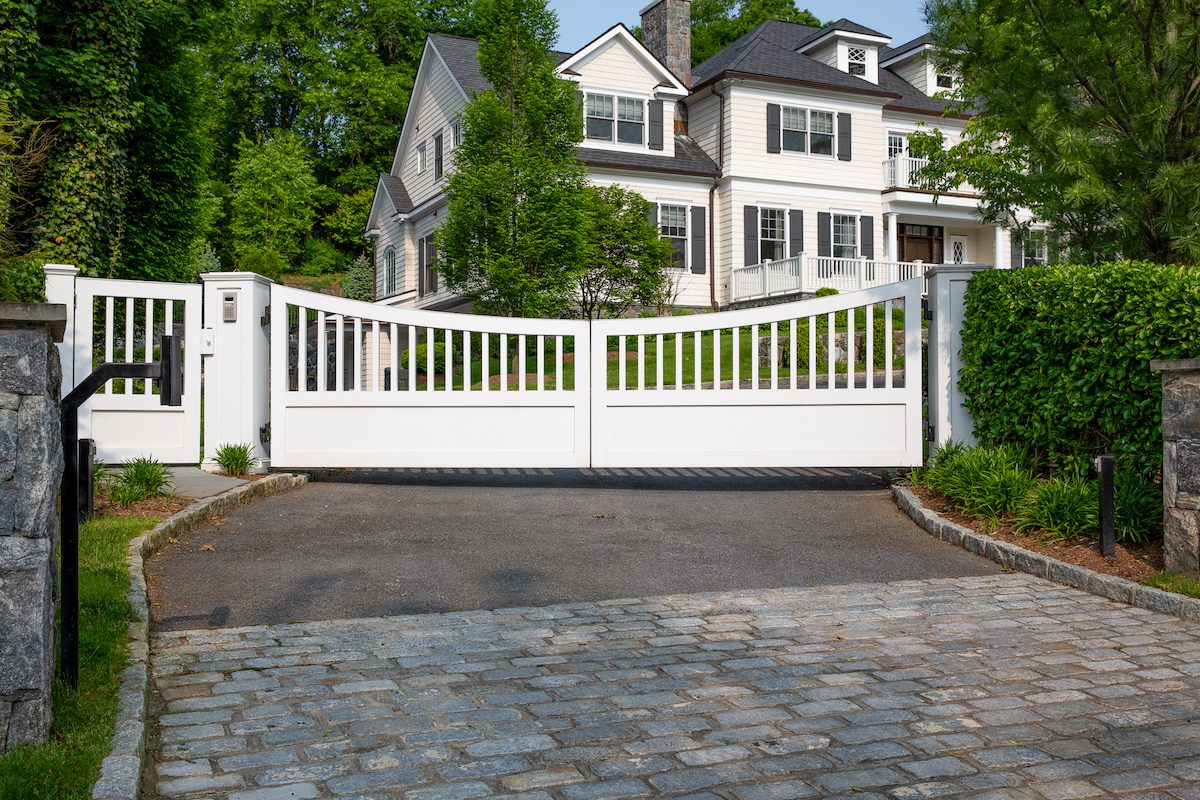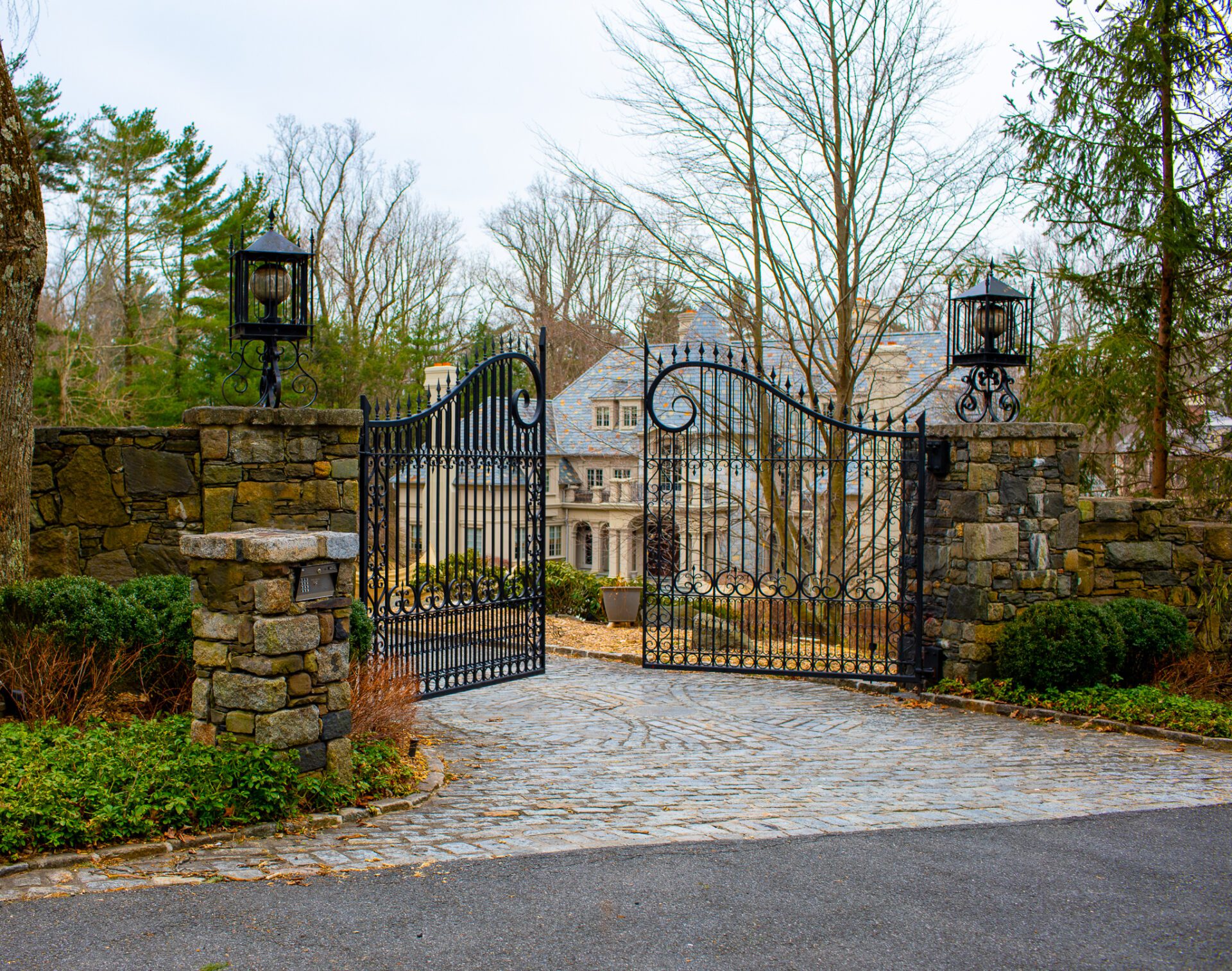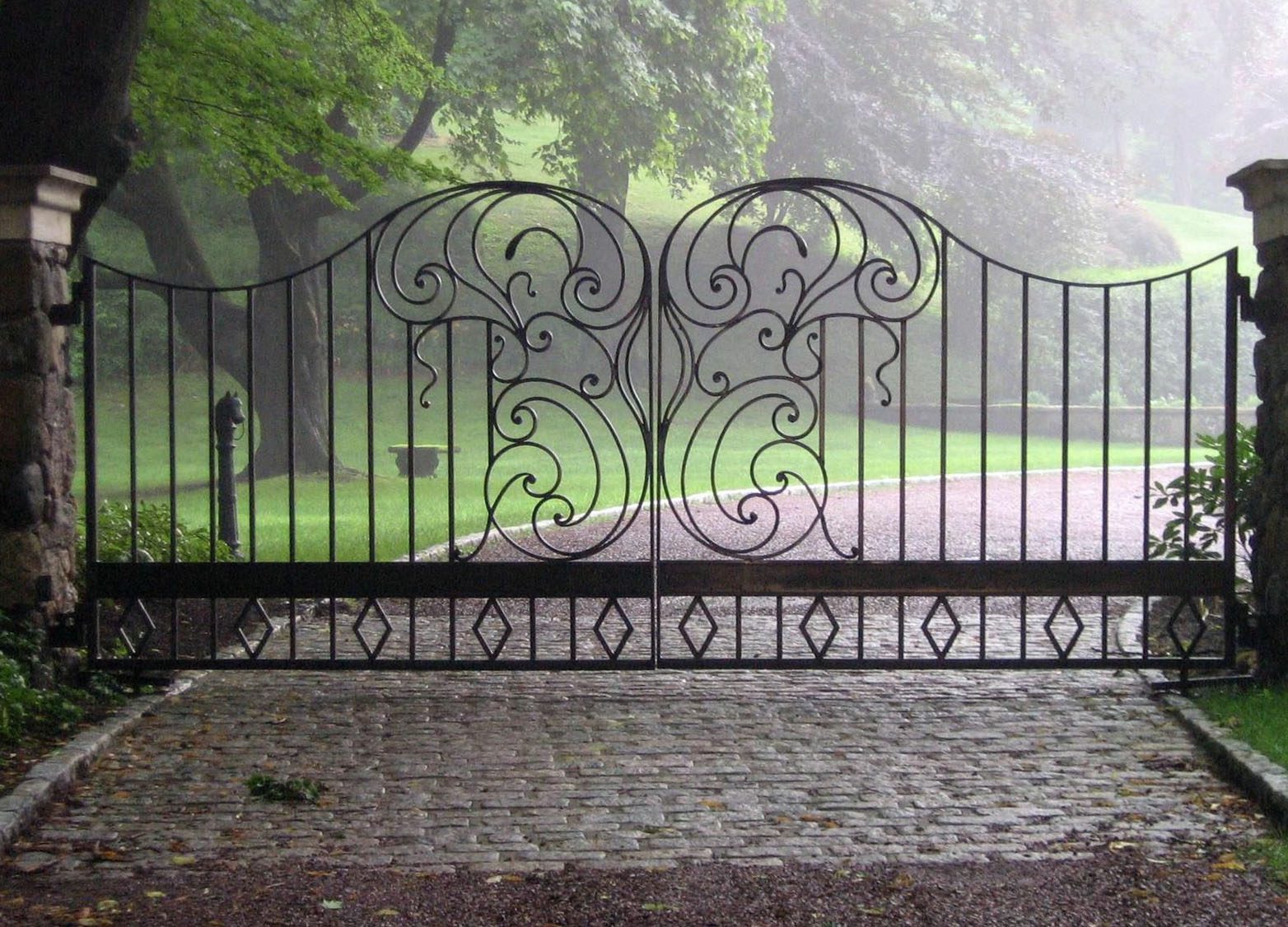You know that saying about the importance of first impressions? Well, the same goes for your home: the first thing visitors see is your driveway, and the overall design sets the tone and atmosphere before guests even set foot inside your house.
That’s why carefully selecting the plants that surround your driveway entrance is an important step. If you’re brainstorming ideas for a perfectly landscaped entrance to your property, this blog is for you. Read on for more driveway design inspiration so you can create the perfect first impression.
Choosing the Best Plants for Lining a Driveway
When choosing your plants, the two most important factors are the physical environment and your aesthetic. Plants have specific tolerances for light, water, and heat, so you want to make sure that whatever you choose will thrive in the conditions around your home. For the aesthetic part, read on for inspiration on how you can create a specific atmosphere around your driveway.
Plants for Driveway Entrances: 12 Design Ideas
Below are 12 stunning design ideas to liven up your driveway.
1. A Portal to Peace
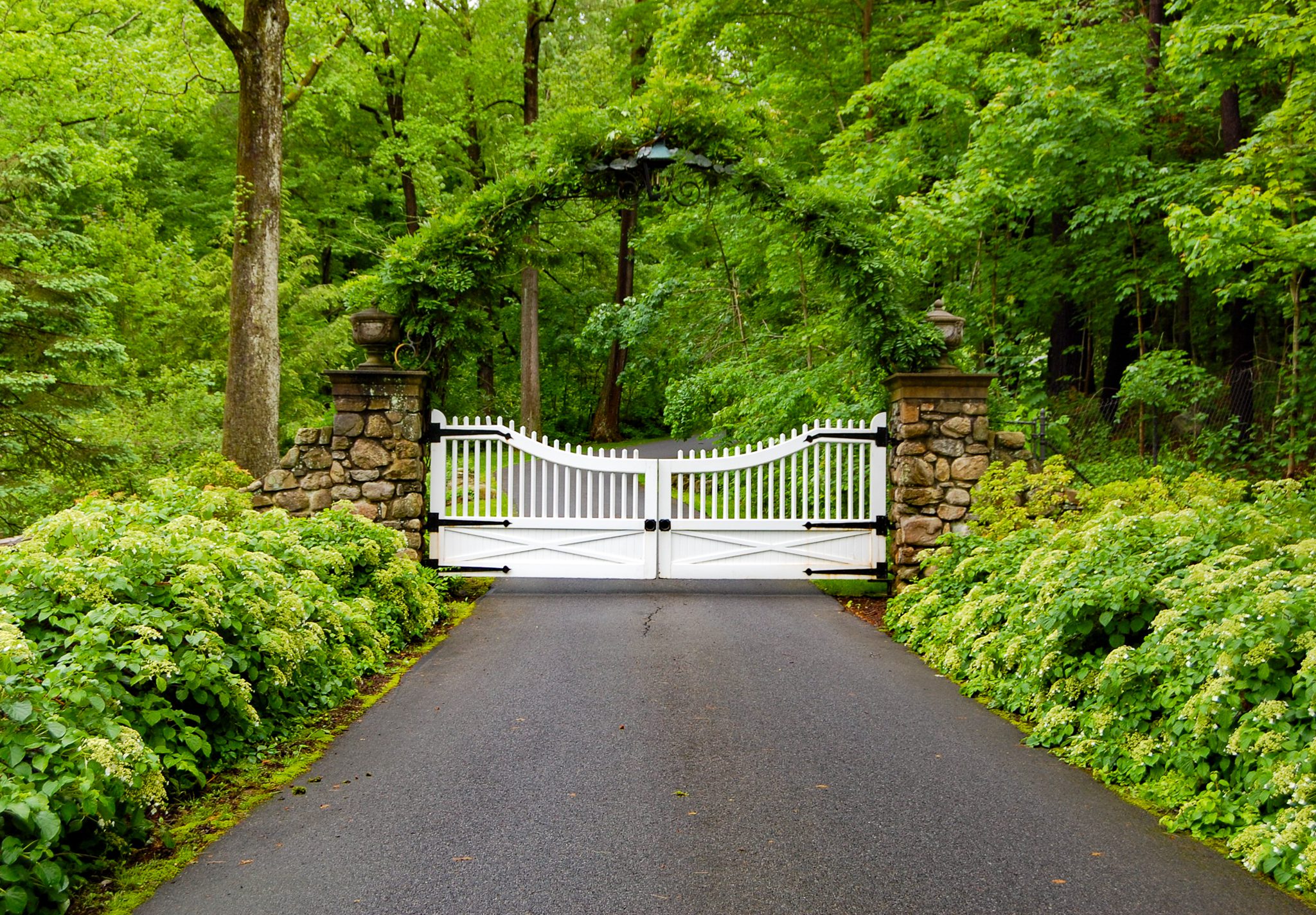
This gorgeous drive is a study in atmosphere. The crisp white wooden gate and sharp black fixtures materialize out of the verdant hydrangeas on either side of the drive, and the wrought iron arch has been covered with vining plants. Hydrangeas are a great choice here: the shrubs fill space and the summer blooms will provide a riot of color, lending even more visual interest. The overall effect is cozy, balancing art and nature.
2. Variations on a Theme
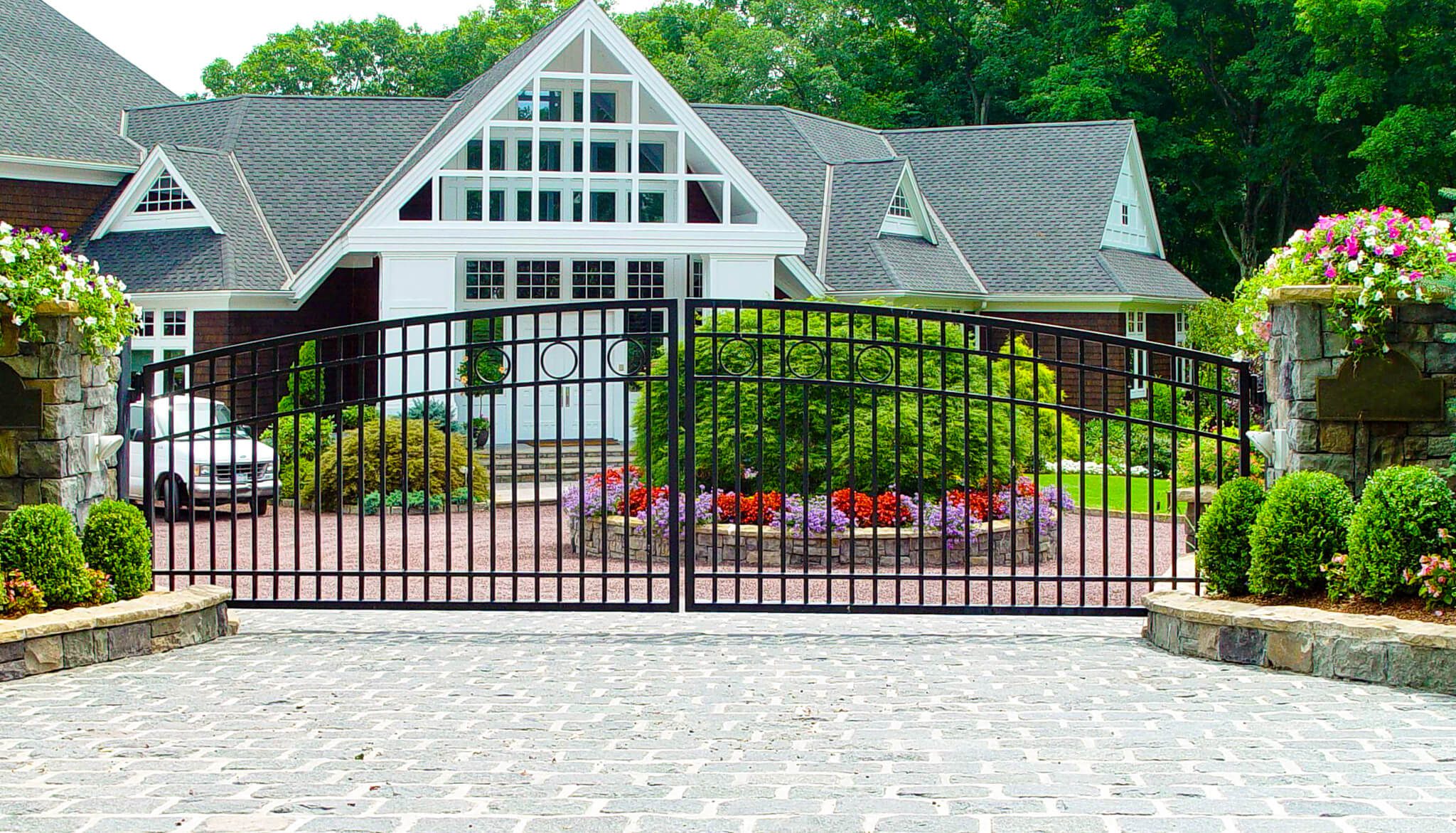
The circular ornamentation in this iron gate complements the repeating square windows and triangular roof peaks on the stunning home behind it. The plants are similarly chosen to provide balance without too much repetition: the small shrubs on either side could be too formal, were it not for the colorful flowers. There are similar touches within the gate, alternating between shaped larger plants and overflowing floral complements.
3. Planting for Privacy
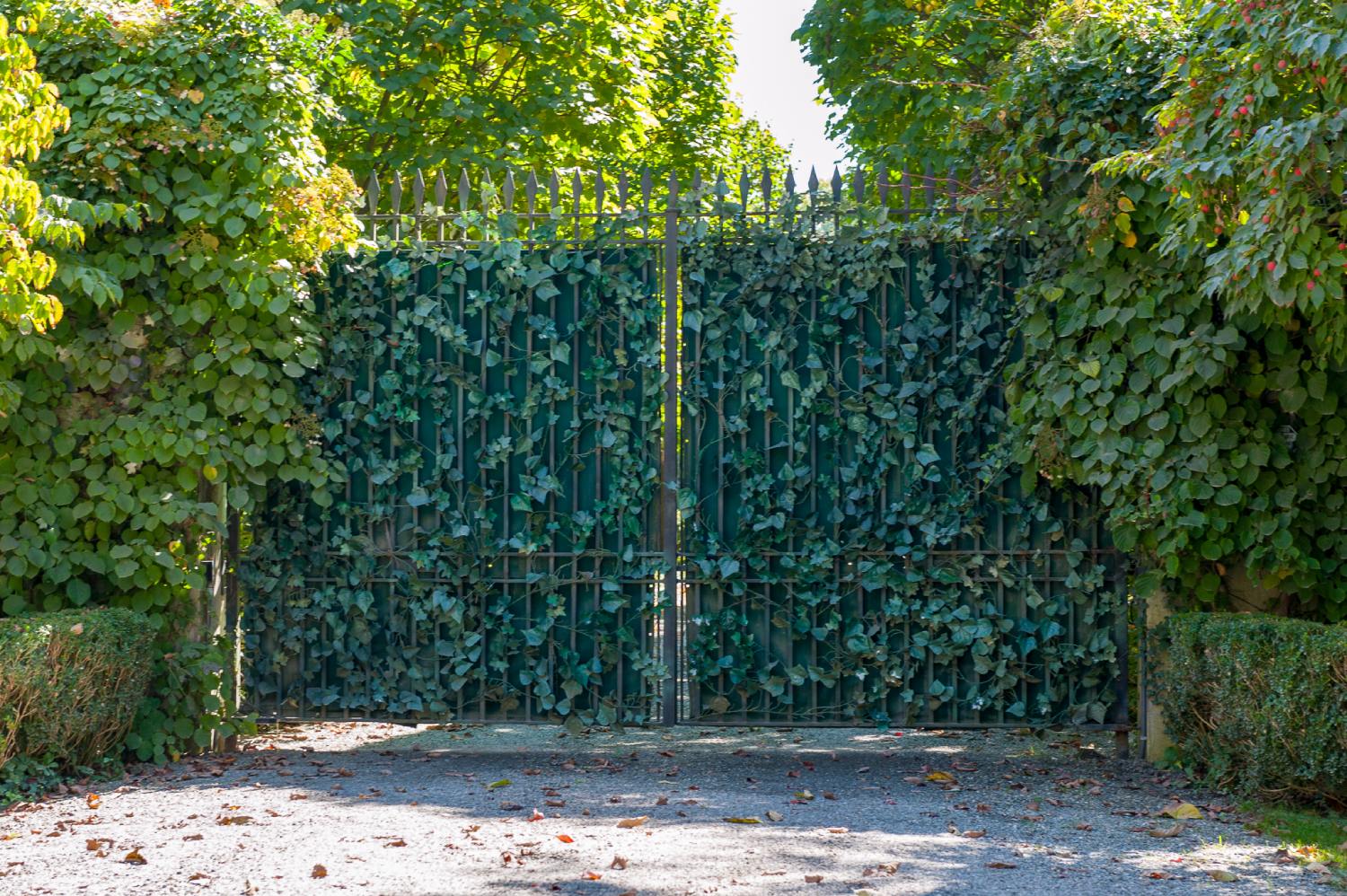
This drive prioritizes privacy, featuring solid paneling, tall iron posts, and climbing vines. If you’re most concerned about protecting your property, consider weaving lush vining plants into your driveway design. The plant growth lends a natural touch, and has the benefit of filling in any gaps between the gate and the posts. Privacy construction can sometimes also serve a dual purpose as a deer barrier; if you have lots of deer around, choose plants that are deer-resistant.
4. Modern Sophistication
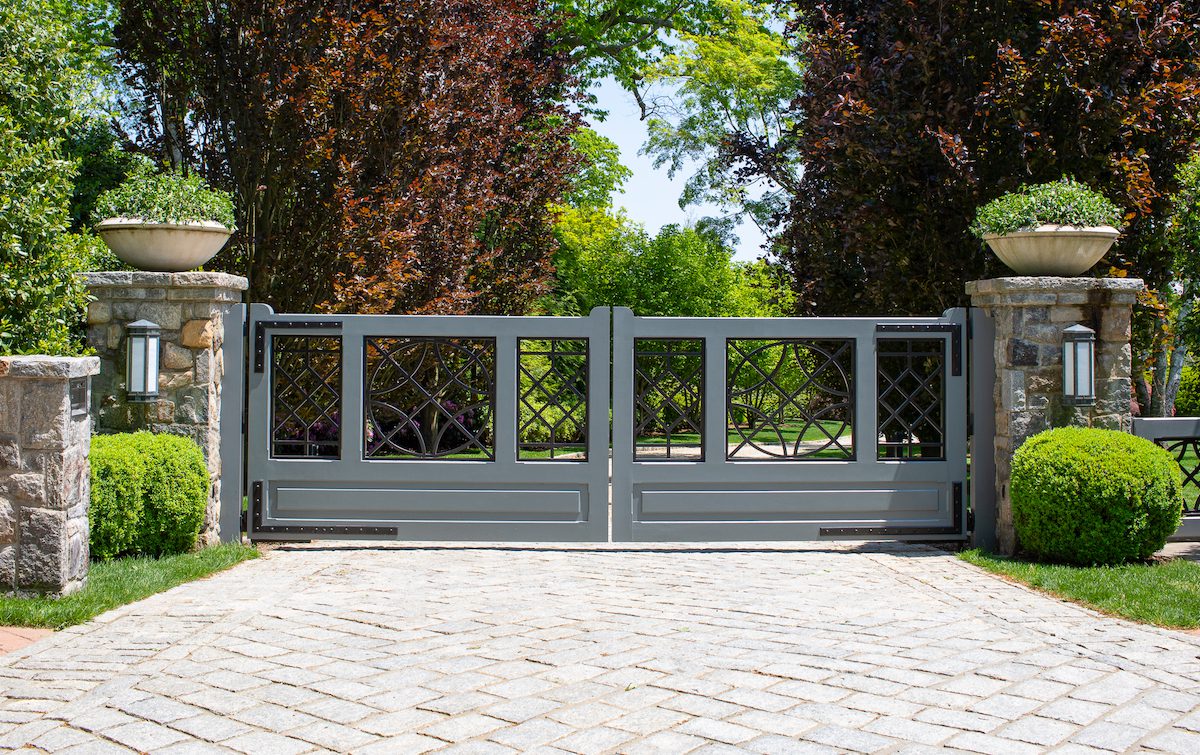
This sleek hybrid gate with custom hardware showcases how modern styles can still be classic; the mix of wood and metal is a staple of contemporary design. The metal elements here are patterned after stained glass, anchoring the modern in the traditional. The gate opens along a flagstone path with mature trees on either side, gently guiding you home. For the ornamental stone bowls, consider a mix of vining plants with colorful flowers to add height and visual interest.
5. Short and Sweet
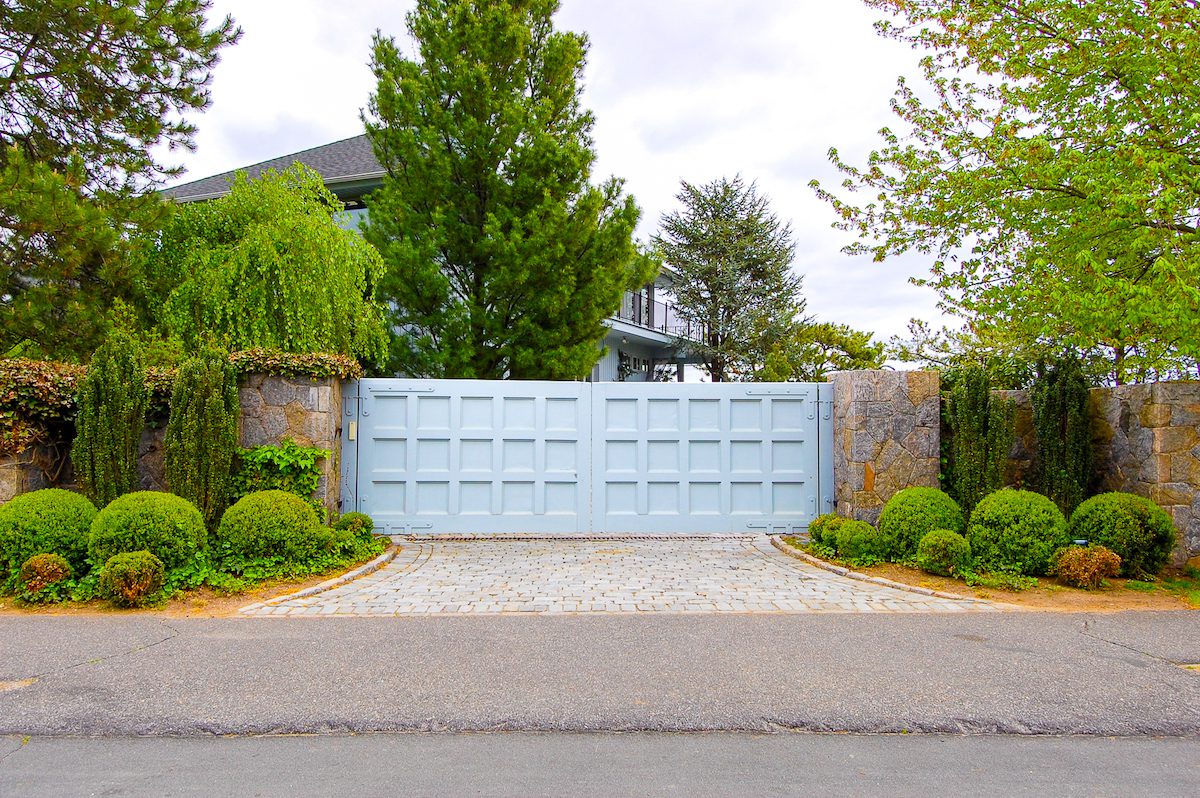
This short drive makes the most of the space by placing shrubs in ascending order of height. The effect is one of solidity, almost as if the plants are shoring up the stone wall behind them. The gate is solid too, a beautiful, easy-to-maintain composite material in a lovely pale blue that complements the house behind it. The mix of shrubs as well as the mature trees visible behind highlight that you don’t need a long drive to create an oasis: the plants help separate the nearby road from the home, and have the additional benefit of dampening road noise.
6. Follow the Brick Road
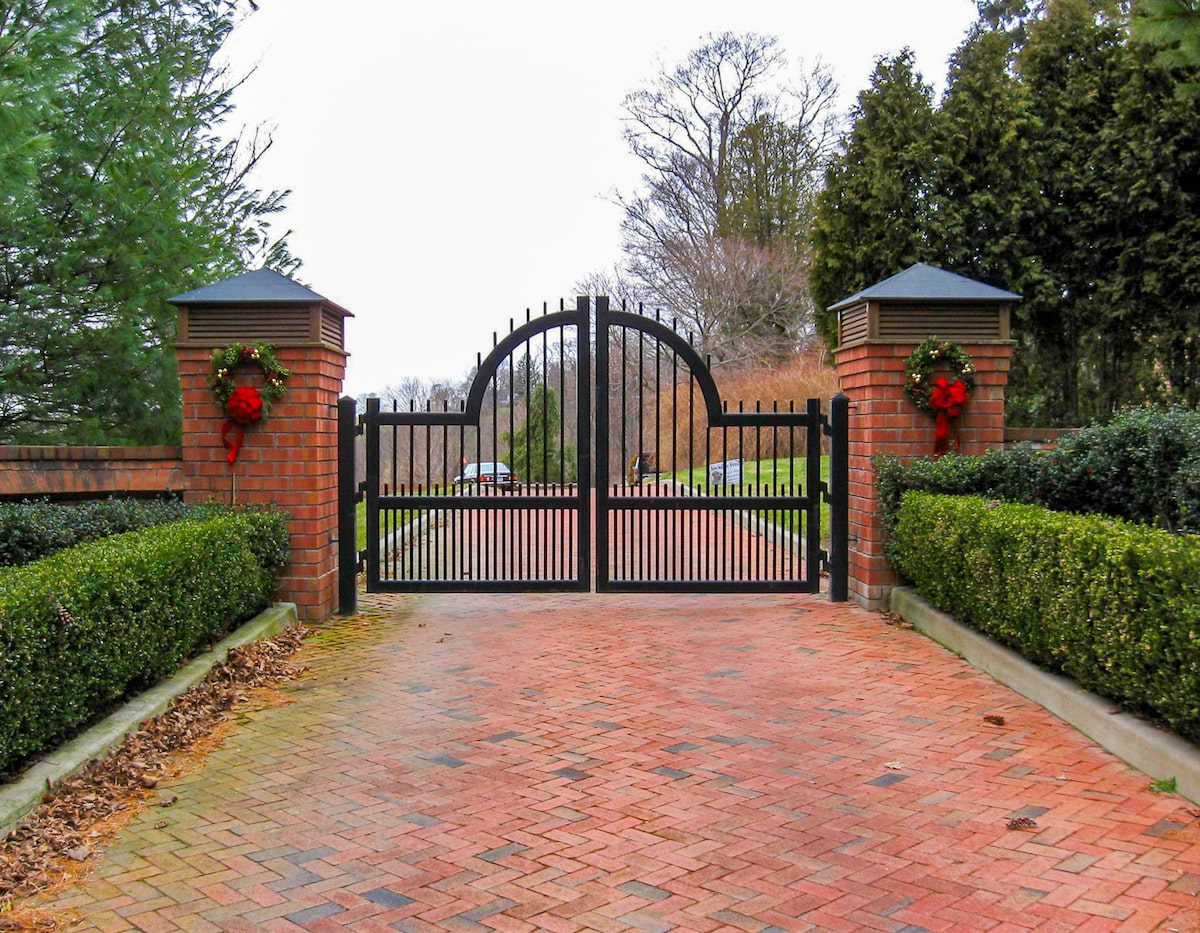
Brick never goes out of style, especially in the Northeast: the wood-topped brick pillars evoke the colonial saltbox style. The evergreen shrubs on either side are easy to maintain: choose a varietal with a height of 6’-8’ so as the shrubs grow, a tunnel effect is created. Alternately, keep the shrubs short so as not to distract from the classic brick and iron path.
7. Light and Airy
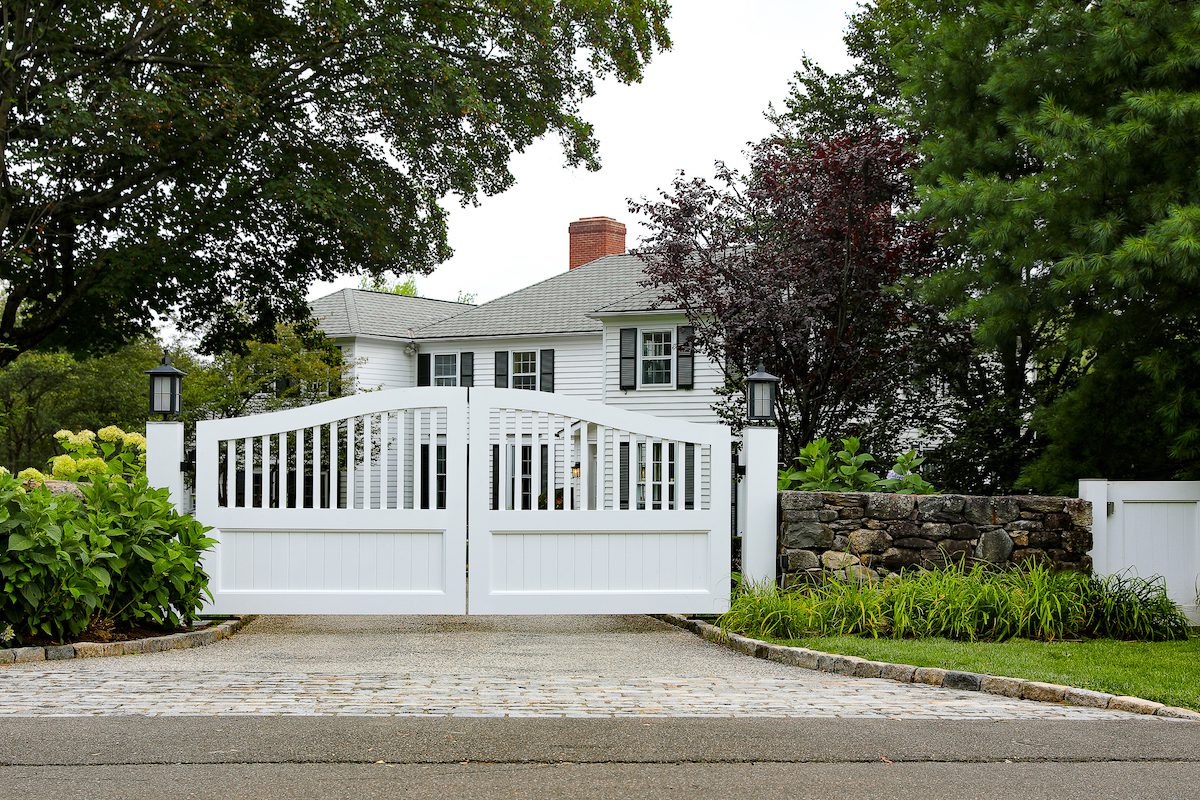
This driveway is the perfect example of the power of plants to change the feel of a landscape. Where above we saw how ascending shrubs could create solidity and safety, here the asymmetrical mix of hydrangeas and lilies lends lightness and airiness. The white pickets of the composite gate separates the home from the road, while the custom lights built into the gate posts welcome visitors through long winter nights.
8. Minimum Landscaping, Maximum Impact
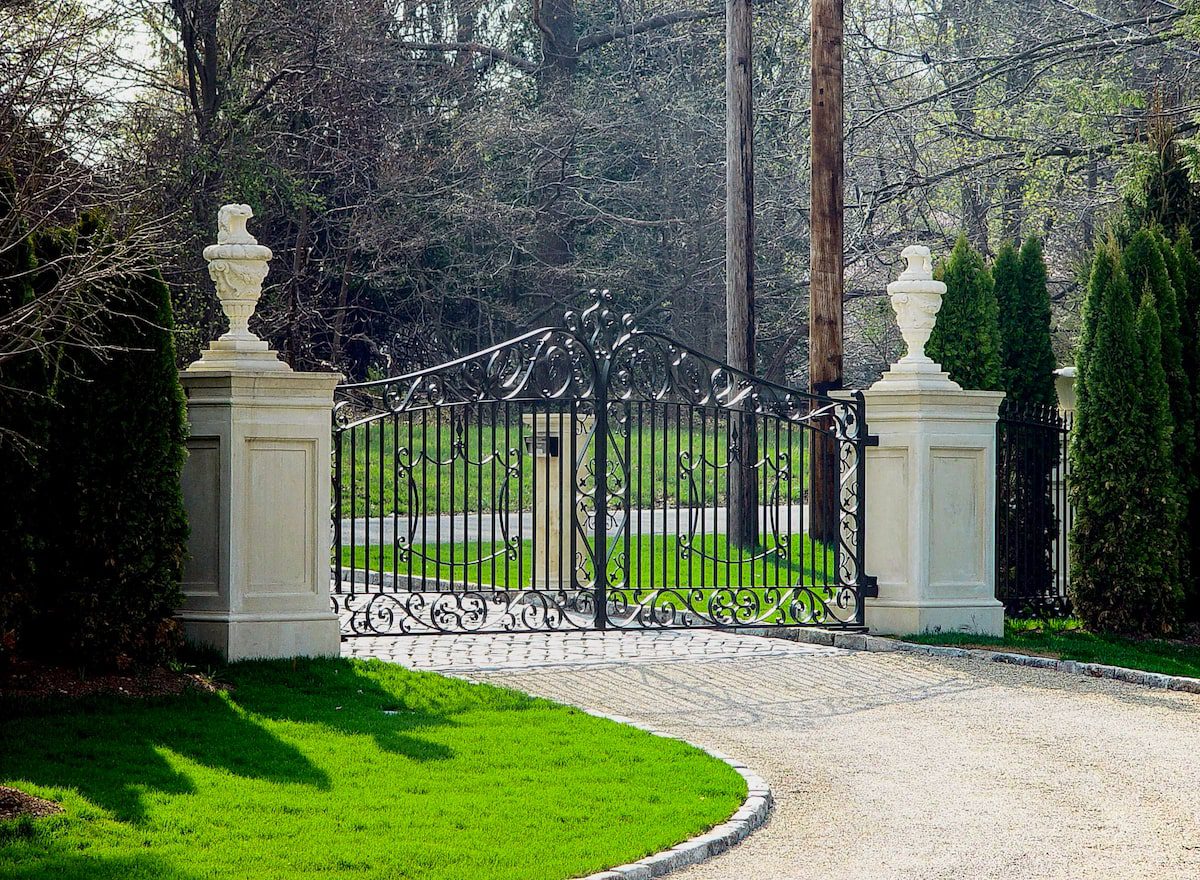
For maximum impact, sometimes less is more. For this stunning custom wrought iron gate with stone pillars, the plants needed to be similarly majestic, making tall evergreens a great choice. They can be left to grow naturally, or shaped to complement your hardscape. Additionally, they provide privacy and dampen any road noise that might be present.
9. Mixed Media
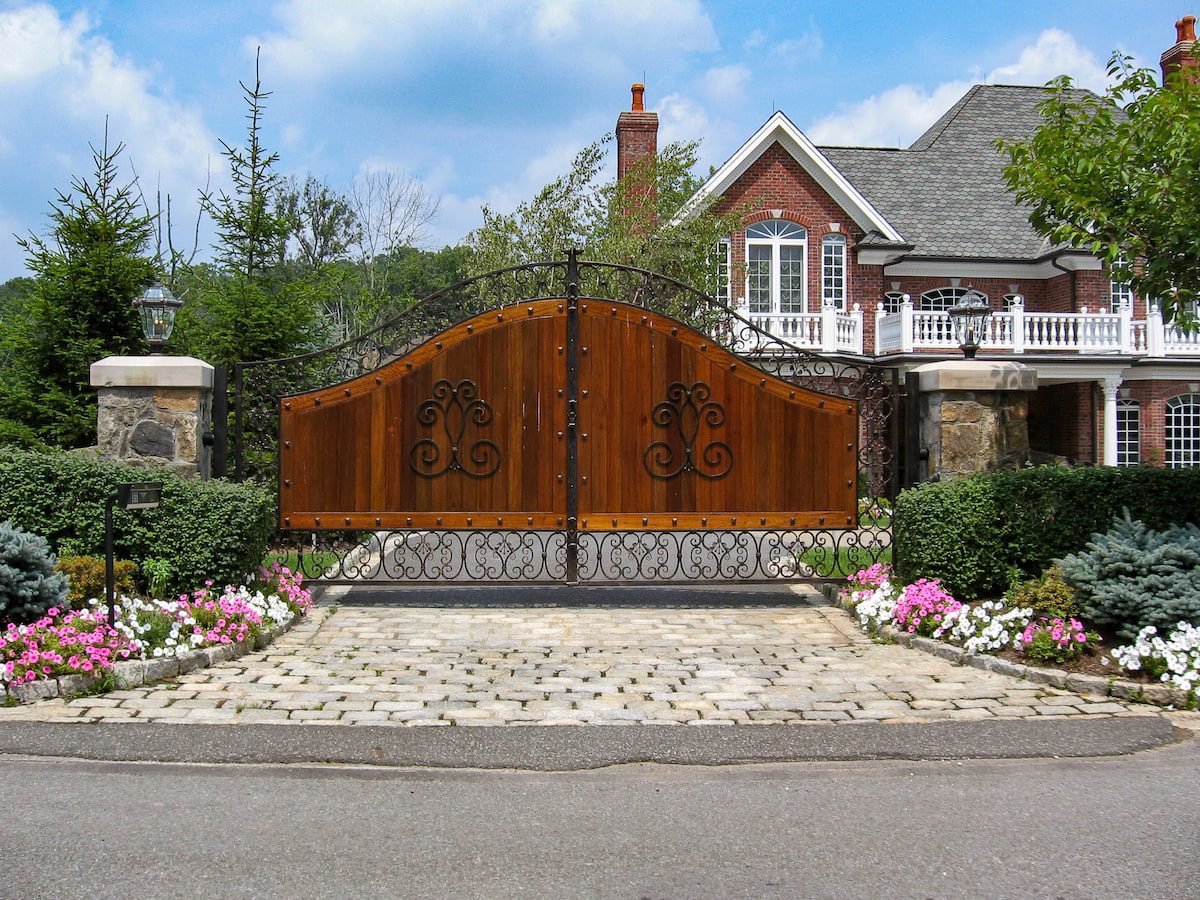
Just as this gate mixes solid wood panels with ornamental ironwork, its surroundings are a gorgeous example of integrating custom hardscape elements like pillars and lamps with the softscape elements of shrubs and flowers for an overall harmonious effect. For the floral elements, choose something that can also serve as a groundcover; the plants will spread and fill in the gaps between shrubs as they mature. The shrubs here cover the half stone wall, softening the landscape.
10. Native Plants
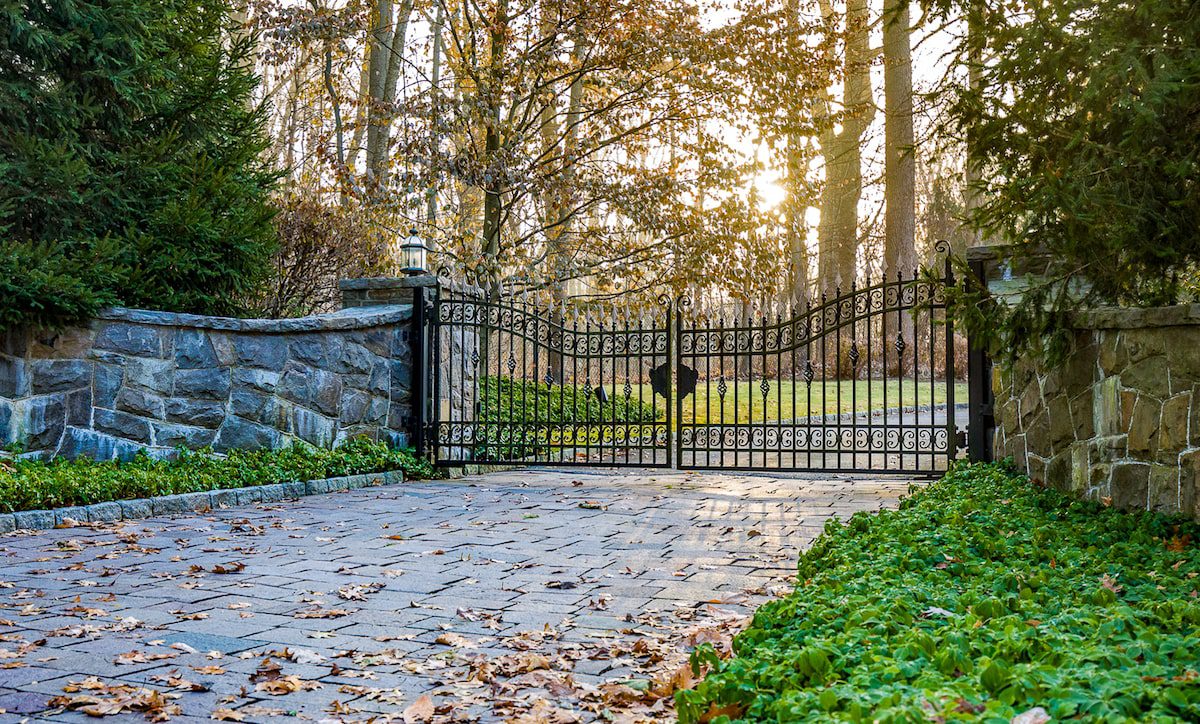
One important factor in good landscaping is choosing plants that will thrive in the sun and water available in their location: native plants have a real advantage here. The pachysandra ground cover serves as a luscious framing to the ornate custom ironwork of the gate, and the mature trees reinforce the boreal feeling.
11. Year-Round Greenery
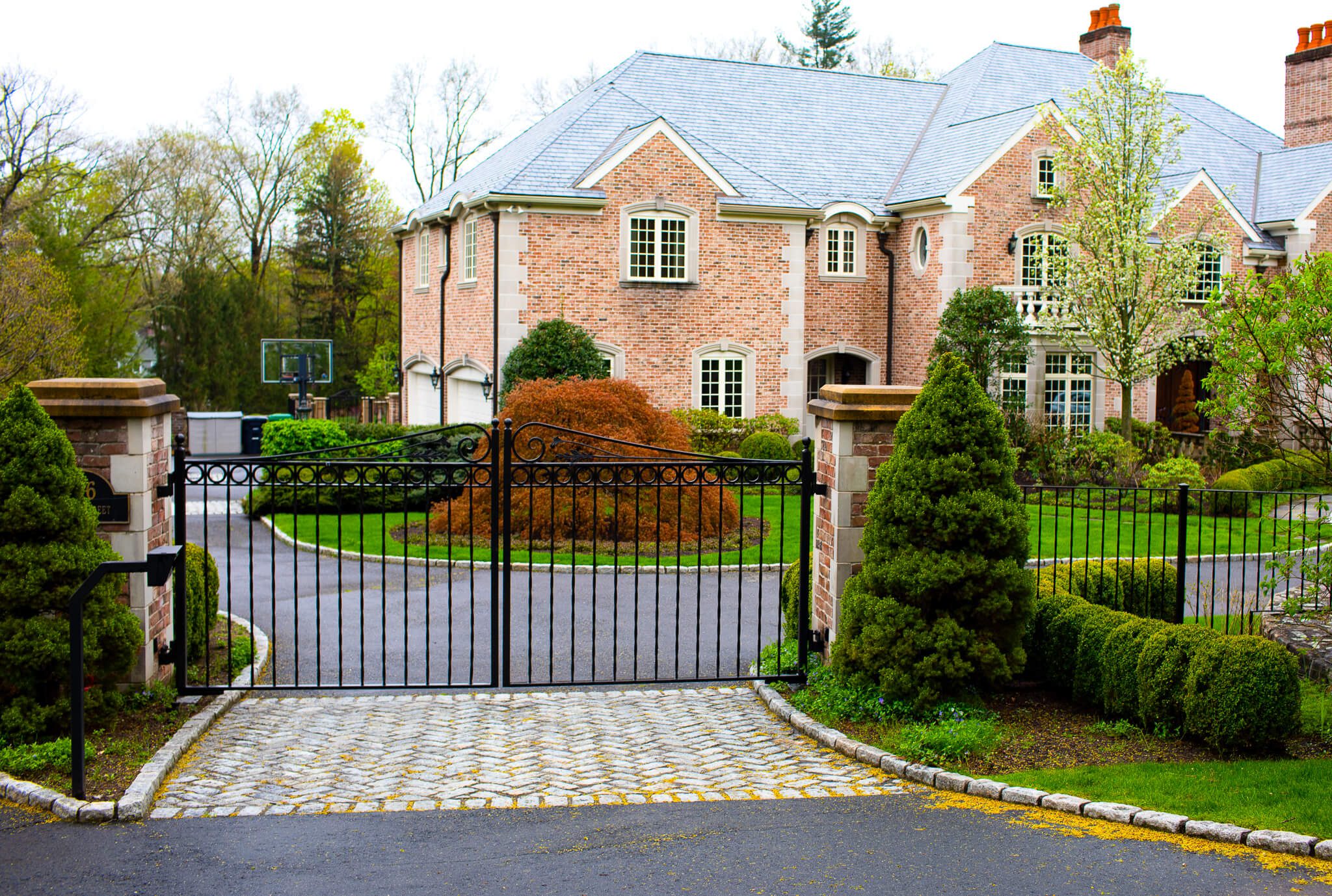
Evergreen bushes provide visual interest year round, and are wonderfully low-maintenance. If your aesthetic leans more minimalist, consider following this example and provide variety through planting different kinds of evergreens. The two framing the gate show how shaping provides further visual interest, and echoes the spiral bushes next to the front door of the home.
12. Oasis in Green
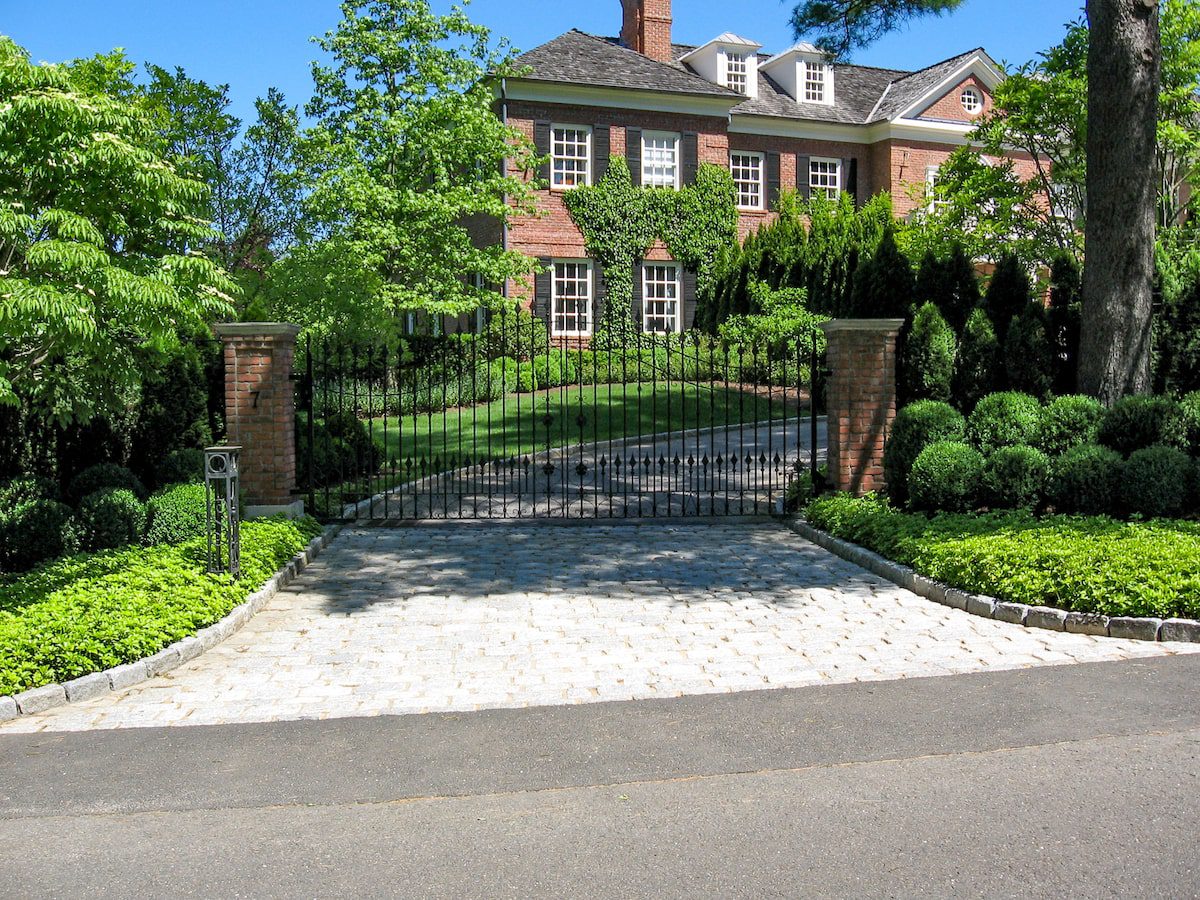
Evergreens are popular for a reason: they’re hardy through harsh winters, need very little maintenance to thrive, and come in nearly endless varietals to suit your exact aesthetic. Here they’re combined with native groundcover plants and climbing ivy on the red brick house to create a year-round green oasis. The custom wrought iron gate lends a further note of elegance to the estate.
FAQs about Plants for Driveway Entrances
Starting a new project can be exciting and sometimes confusing: there are so many options! Below are some frequently-asked questions that can help you make the best choice for your driveway.
What Plants Are Most Suitable for Driveway Entrances in the Northeast?
Here in the Northeast, we have four distinct seasons, including hot, humid summers and cold, snowy winters. When choosing plants for your driveway entrance, you’ll need to consider several factors, including:
- Sun exposure: How much sun does the area receive? Plants suited for full sun won’t do well in shady areas, and vice versa.
- Soil drainage: Does the water drain well from the soil, or does it tend to pool? Plants that don’t tolerate wet feet will need well-drained soil.
- Salt tolerance: If your driveway is salted in the winter, you’ll need to choose plants that are tolerant of salt spray
What Are Some Colorful Plants for Driveway Entrances?
When choosing colorful plants, consider their peak blooming season so you can have riots of color spring, summer, and fall. Here are some options:
Spring flowering perennials:
- Columbine (Aquilegia canadensis): A native wildflower with distinctive red and yellow flowers that dangle from wiry stems above lacy foliage in spring. Prefers part shade to full shade and moist, well-drained soil.
- Coral bells (Heuchera spp.): A low-growing perennial with colorful foliage in shades of red, purple, orange, and green. Some varieties also have white or pink flowers in spring. Prefers part shade to shade and moist, well-drained soil.
- Bleeding heart (Dicentra spectabilis): A shade-loving perennial with heart-shaped pink flowers in spring.
- Creeping phlox (Phlox subulata): A low-growing perennial with masses of small, colorful flowers in spring. Prefers full sun to partial shade and well-drained soil.
Summer flowering perennials:
- Daylily (Hemerocallis spp.): A low-maintenance perennial with trumpet-shaped flowers in a wide range of colors, including red, orange, yellow, pink, and purple. Blooms throughout the summer. Prefers full sun to part shade and well-drained soil.
- Coneflower (Echinacea purpurea): A daisy-like flower with drooping petals in shades of purple, pink, orange, and yellow. Blooms in mid to late summer. Prefers full sun and well-drained soil.
- Russian sage (Perovskia atriplicifolia): A tall perennial with lavender-blue flowers that bloom in late summer and early fall. Prefers full sun and well-drained soil.
- Catmint (Nepeta x faasseni): A low-growing perennial with fragrant lavender flowers that bloom all summer long. Prefers full sun and well-drained soil.
- Thyme (Thymus spp.): A low-growing herb with fragrant foliage and small flowers in spring or summer. Prefers full sun and well-drained soil. There are many varieties of thyme with different colored foliage
Fall flowering perennials:
- Chrysanthemum (Chrysanthemum spp.): A fall-blooming perennial with daisy-like flowers in a wide range of colors, including red, orange, yellow, pink, and purple. Prefers full sun and well-drained soil.
- New England aster (Aster novae-angliae): A tall perennial with purple or blue flowers that bloom in late summer and fall. Prefers full sun to part shade and moist, well-drained soil.
What Are Some Evergreen Plants for Driveway Entrances?
Evergreens are a great choice for a driveway entrance in the Northeast because they provide year-round interest and beauty. Here are some colorful evergreen options that will thrive in the Northeast climate:
- Arborvitae (Thuja spp.): Arborvitae are fast-growing evergreens that come in a variety of sizes and shapes, from tall and slender to dwarf and rounded. They have green or yellow foliage and can be pruned into formal shapes or left to grow naturally.
- Yew (Taxus spp.): Yews are slow-growing evergreens that are perfect for foundation plantings. They have dark green foliage and can be pruned into hedges or topiaries.
- Holly (Ilex spp.): Hollies are popular evergreens that come in a variety of sizes and shapes. They have green or variegated foliage and many varieties produce bright red berries in winter. However, some holly varieties have berries that are poisonous, so be sure to choose a non-poisonous variety if you have children or pets.
- Rhododendron (Rhododendron spp.): Rhododendrons are broadleaf evergreens that come in a wide range of colors, including red, pink, white, and purple. They bloom in spring and their large, glossy leaves provide year-round interest. Rhododendrons prefer partial shade to full shade and moist, well-drained soil.
How Do I Choose the Right Plants for the Size of My Driveway Entrance?
Choosing the right size plant for your driveway entrance involves considering several factors:
- Mature size of the plant: This is the most crucial factor. Planting a large tree too close to the house or driveway will cause problems when it matures. Pay attention to the plant’s width and height at maturity, not just its current size.
- Spacing between plants: Plants need room to grow and shouldn’t be crowded together. Factor in how much space mature plants will need when placing them.
- Distance from the house and driveway: Account for how close the plant will be to structures and walkways. You don’t want to block windows or impede visibility when entering or exiting the driveway. Here’s a general guideline:
- 3-5 feet from the house: Low-growing shrubs, flowers, or ornamental grasses
- 5-8 feet from the house: Mid-sized shrubs
- 8+ feet from the house: Large shrubs or small trees
Here are some additional tips for choosing the right size plant for your driveway entrance:
- Measure your space: Before you go to the nursery, measure the length, width, and height of the planting area. This will help you determine how many plants you can fit and what size plants will work best.
- Draw a plan: Sketch out a simple plan of your driveway entrance, including the location of any existing plants, walkways, and other features. This will help you visualize how different sized plants will look in the space.
- Think about scale: The size of your driveway entrance will also play a role in choosing the right size plant. A large driveway can handle larger plants, while a small driveway will look overwhelmed by large plantings.
- Err on the side of smaller: It’s always better to err on the side of planting smaller plants that will grow into the space than to plant something that is too large from the start.
Remember, a good rule of thumb is to allow for at least 2-3 feet of clearance between mature plants and walkways or driveways.
Design Your Perfect Driveway Entrance with Tri State Gate
Eager for more examples? Check out 35 Modern Driveway Gate Ideas for Inspiration in 2024. For over 25 years, we here at Tri State Gate in Westchester County have been helping homeowners throughout Connecticut, New York, and New Jersey design the driveway entrances of their dreams. Contact us today to consult with one of our experts or receive a free consultation! We’re excited to help you design the perfect gate for your property.

